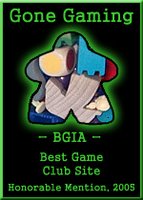Kozure, in one of his more sadistic choices, decided to foist upon our inexperienced group a game of High Frontier, WITH EXPANSION. Shemp prepared the room in case of brain asplosion.
Yomi
Kozure and I started with a quick game of Yomi. I played Grave, and got off to an excellent start... succeeding to land every blow I attempted. Kozure fought back to parity and we stayed close until we were both in the low 30s health-wise. That was when I landed the big mega attack for 45 damage, and that was all she wrote...
High Frontier
High Frontier is a challenging game. It's not the rules, though those can be challenging as well, it's that in order to get a succesful mission you have to get the math *just* right. You need to get the right parts that line up with the mission you plan to undertake, then make sure your rocket isn't overburdened by all that tech, then launch it into space and hope you brought along enough fuel to get to where you where wanting to go. Getting this right requires much calculating and recalculating... you can't get it wrong or you waste 30-60 minutes finding out. This is why brains asplode. It's also why I was fearing the expansion.
It turns out the expansion isn't so bad after all. The main addition, besides the expanded map, is a greater array of parts required to build your space rocket (previously, all that was available were thrusters, robonauts and refineries). Now, these same main elements are supplemented with reactors, radiators and generators. Some parts are interdependent, for example a particular reactor might need a level 2 radiator. It works, and provides more interesting combinations and possibilities without being too complex. This part works very nicely in my opinion.
There are other additions, such as politics, environments, glitches, etc. These had a very mild impact on our game, so it's hard to say if they were any good. My first impression is that they are not worth the overhead, but that could be just because of the way our session played out.
I have a feeling that the expanded game is really just the whole game the designer wanted to publish, before he was convinced that it would be too complicated. The whole experience feels more fleshed out, and I for one liked it better this way. Complexity be damned!
We didn't manage to finish the game. I managed to pull together a combination of equipment that gave me a heavy, high thrust ship. I flew to Mars and built my first factory and decommissioned everything. I then built the same rocket and went to the nearest M planet that I could explore, which was on the expansion board (technically, the closest planet is Hartha but Kozure would be getting there before me).
I think it happened to all of us, but in the confusion of trying to assemble these complicated ships parts kept getting left behind. In my case, I showed up at said M planet and realized I forgot the device that allowed me a re-roll in case of failure (odds where 50-50 of success without it). I did succeed, but if I had failed the whole mission would have gone down the toilet because there was 0 fuel left after I got there.
High Frontier is a fun, but very challenging game. Mechanically, it feels like it could use further development, but regardless it's quite an intriguing and immersive challenge. It's definitely right up there in terms of games I know I will remember when I look back someday.
Dixit
Just as we were packing up, Kozure pulled out Dixit so we could take a look. I suggested we play a round or two, just to see how it plays. It was the perfect relaxing type of game to follow High Frontier so we went with it and played out the whole game.
Dixit is the Spiel de Jares winning party game. Players are dealt a hand of cards depicting surreal images and each round a the acting player needs to select one and come up with a clue based on the image. All the other players must select a card from their hand that they feel also matches the clue, and all selected cards are mixed together. Points are then awarded based on how many people select the active player's card. As is often the case with these types of games, the acting player must select a clue that is neither too obvious or too obscure because there are no points awarded to the acting player if everyone or no one gets it right.
The images are quite nice and evocative, and the process of inventing descriptive clues for the images is fun. Ultimately, it's just an apples 2 apples clone, but a little more cerebral and involving more creativity.
Subscribe to:
Post Comments (Atom)


I'm very glad you liked it.
ReplyDeleteThere's a couple "quick start" variants being tossed about now. They include:
Getting one card from EVERY draw pile - so six cards to start.
Someone also suggested starting with the same cash you would get with selling a card from each main pile (3 x 3WT). One could extend that so that you get cash equivalent to the variant above, so that you start with 18 WT (6 x 3WT).
I think the variant with 6 cards would give Shimuzu an unfair advantage for a few turns while other players sold their crap. Similarly, 18 WT would be a little too rich, I think.
9 WT start sounds about right.